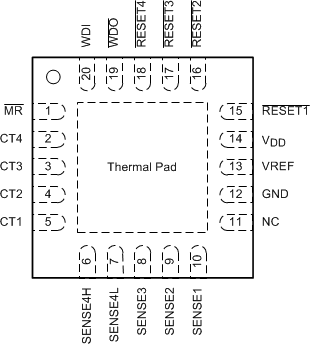SBVS149B September 2010 – January 2016 TPS386000-Q1
PRODUCTION DATA.
- 1 Features
- 2 Applications
- 3 Description
- 4 Revision History
- 5 Pin Configuration and Functions
- 6 Specifications
- 7 Parametric Measurement information
- 8 Detailed Description
- 9 Application and Implementation
- 10Power Supply Recommendations
- 11Layout
- 12Device and Documentation Support
- 13Mechanical, Packaging, and Orderable Information
5 Pin Configuration and Functions
RGP Package
20-Pin VQFN With Thermal Pad
Top View

NC = No internal connection
Pin Functions
| PIN | I/O | DESCRIPTION | ||
|---|---|---|---|---|
| NAME | NO. | |||
| CT1 | 5 | — | Reset delay programming pin for SVS-1 | Connecting this pin to VDD through a 40-kΩ to 200-kΩ resistor, or leaving it open, selects a fixed delay time (see the Electrical Characteristics). Connecting a capacitor > 220 pF between this pin and GND selects the programmable delay time (see the Reset Delay Time section). |
| CT2 | 4 | — | Reset delay programming pin for SVS-2 | |
| CT3 | 3 | — | Reset delay programming pin for SVS-3 | |
| CT4 | 2 | — | Reset delay programming pin for SVS-4 | |
| GND | 12 | — | Ground | |
| MR | 1 | I | Manual reset input for SVS-1. Logic low level of this pin asserts RESET1 or RESET1. | |
| NC | 11 | — | Not connected. TI recommends to connect this pin to the GND pin (pin 12), which is next to this pin. | |
| RESET1 | 15 | O | Active low reset output of SVS-1 | RESETn is an open-drain output pin. When RESETn is asserted, this pin remains in a low-impedance state. When RESETn is released, this pin goes to a high-impedance state after the delay time programmed by CTn. |
| RESET2 | 16 | O | Active low reset output of SVS-2 | |
| RESET3 | 17 | O | Active low reset output of SVS-3 | |
| RESET4 | 18 | O | Active low reset output of SVS-4 | |
| SENSE1 | 10 | I | Monitor voltage input to SVS-1 | When the voltage at this terminal drops below the threshold voltage (VIT–), RESET1 is asserted. |
| SENSE2 | 9 | I | Monitor voltage input to SVS-2 | When the voltage at this terminal drops below the threshold voltage (VIT–), RESET2 is asserted. |
| SENSE3 | 8 | I | Monitor voltage input to SVS-3 | When the voltage at this terminal drops below the threshold voltage (VIT–), RESET3 is asserted. |
| SENSE4L | 7 | I | Falling monitor voltage input to SVS-4. When the voltage at this terminal drops below the threshold voltage (VIT–), RESET4 or RESET4 is asserted. | |
| SENSE4H | 6 | I | Rising monitor voltage input to SVS-4. When the voltage at this terminal exceeds the threshold voltage (VIT+), RESET4 or RESET4 is asserted. This pin can also be used to monitor the negative voltage rail in combination with VREF pin. | |
| VDD | 14 | I | Supply voltage. TI recommends connecting a 0.1-μF ceramic capacitor close to this pin. | |
| VREF | 13 | O | Reference voltage output. By connecting a resistor network between this pin and the negative power rail, SENSE4H can monitor the negative power rail. This pin is intended to only source current into resistor(s). Do not connect only capacitors and do not connect resistor(s) to a higher voltage than this pin. | |
| WDI | 20 | I | Watchdog timer (WDT) trigger input. Inputting either a positive or negative logic edge every 610 ms (typical) prevents WDT time out at the WDO or WDO pin. Timer starts from releasing event of RESET1 or RESET1. | |
| WDO | 19 | O | Watchdog timer output. This is an open-drain output pin. When WDT times out, this pin goes to a low-impedance state to GND. If there is no WDT timeout, this pin stays in a high-impedance state. | |
| (Thermal Pad) | (PAD) | — | This is the IC substrate. This pad must be connected only to GND or to the floating thermal pattern on the printed circuit board (PCB). | |